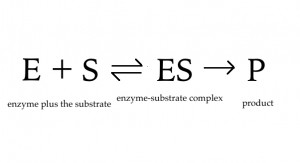This is the fourth installment in the Enzymes for Brewers series.
Biochemists envision enzyme-catalyzed reactions as occurring in two steps. First there’s the formation of the enzyme-substrate complex. Then there is the subsequent formation of the product.
In most realistic situations — and certainly in brewing — the concentration of the enzyme is small compared to that of the substrate. As the concentration of substrate rises, so does the reaction rate, as the average distance between enzyme and substrate is reduced. Put more simply, in a brewing-relevant example, the more starch there is in the mash, the more likely an amylase enzyme floating in the liquid is to bump into a strand of it. At some point, however, enzyme activity does not increase as all the enzyme is tied up in enzyme-substrate complexes.


Recent Comments